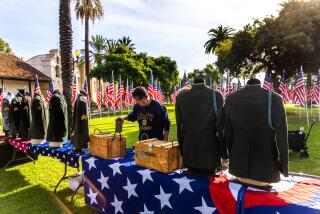Exhibit Gives Expanded View of Area History
- Share via
After three years of research, planning and digging for historical mementos, the Ventura County Museum of History and Art will open its doors Tuesday with a new and expanded exhibit chronicling the county’s colorful history.
In an eclectic collection of memorabilia, historical photographs and artifacts, the new exhibit spans county history from the Chumash era through the 1950s.
From a stone holy water bowl made by Chumash Indians for the Spanish missionaries to a lemon-picking apron from Santa Paula ranches in the 1920s, the exhibit touches on the county’s agricultural tradition and the influx of poor immigrants who came seeking jobs.
After a dozen years of the old exhibit, museum curator Jim Schiffer said it was time for a change.
“Well, everybody was sick of it,” Schiffer said half-jokingly. “It didn’t lend itself well to interpretation and it had no clear narrative thread.”
This exhibit clearly has a theme.
Planned and researched by historians, the new exhibit rejects the theory of Manifest Destiny prevalent among historians when discussing the conquest of the west by East Coast pioneers.
Rather, the exhibit espouses the Rendezvous theory that emphasizes a coming together, though not without tension, of many immigrant groups to the west.
The historians also eliminated some items, like the replica of a clipper ship that was popular among visitors but in fact had no local historical significance.
But they also brought in new items, such as a 17th-century canon used to protect the San Buenaventura Mission. The weapon was stored in the museum’s basement and its canon balls were recently found by Main Street residents digging in their backyards.
The new exhibit is divided into three time periods, the Pastoral Era from prehistory to the 1850s, the Commercial Era, which began in the last half of the 19th century, and the Industrial Era, which covers the 1920s to the present.
More to Read
Sign up for Essential California
The most important California stories and recommendations in your inbox every morning.
You may occasionally receive promotional content from the Los Angeles Times.













